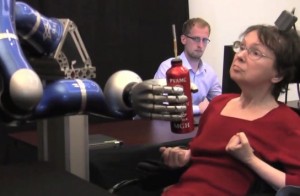
A woman uses the BrainGate system to mentally control a robotic arm and reach for a drink. (Photo: The BrainGate Collaboration)
Almost 15 years after being paralyzed by a stroke, a 58-year-old woman was able to reach for, pick up and take a sip of a drink, by using her thoughts to operate a robotic arm. Up until then, the woman had depended upon caregivers to do this for her.
As technology continues to meld man with machine, BrainGate – a multidisciplinary team of researchers – has spent years developing these human/robotic-type systems.
While the team’s innovations show significant promise for people with brain injuries and disorders, the technology is years away from practical use.
The research team has recently been developing and testing an element of their system called the BrainGate neural interface system. It’s a brain-computer interface (BCI) device which allows the brain to control various robotic elements and other similar pieces of equipment.
A new report, published in Nature, examines clinical trials of the device, which focus on the system’s durability and its potential for long-term use.
Part of the BrainGate system is implanted in the brain to capture the neural signals that control intentional movement.
“Years after the onset of paralysis, we found that it was still possible to record brain signals that carry multi-dimensional information about movement and that those signals could be used to move an external device,” said Dr. Leigh Hochberg, the clinical trials lead investigator.
The group’s neural interface system has a baby aspirin-sized sensor that monitors brain signals. The sensor is implanted into the motor cortex, the part of the brain that controls movement. The brain signals picked up by the sensor are then fed into a computer system outfitted with specially-designed software and hardware which turn the brain signals into digital commands, which in turn drive external devices such as robotics systems.
The latest trial research studied two stroke patients, the 58-year-old woman and a 66-year-old man. Both study subjects were unable to speak or move their limbs because of brainstem strokes they suffered years ago. During the experiment, both were taught to perform complex tasks with a robotic arm by imagining the movements of their own arms and hands.
Dr. John Donoghue, who leads the development of BrainGate technology, is especially encouraged by the woman’s ability to use the BrainGate neural interface system because her stroke happened nearly 15 years ago and her sensor was implanted more than five years ago.
The research team was concerned neurons in the motor cortex might die or stop generating meaningful signals after years of disuse and that, after years since implantation, the sensor might break down and become less effective at enabling complex motor functions
The BrainGate research team’s ideal system would be wireless, fully automated and able to provide decades of stable operation. However, to achieve that goal, they must continue trial studies and test the technology in more individuals.
UItimately, BrainGate hopes to develop a system which reconnects the brains of those suffering from paralysis directly to their paralyzed limbs, rather than with robotic ones.





















Great breakthrough, but can this humanistic intelligencies be affordable
affordable in every home of paralysis patients?